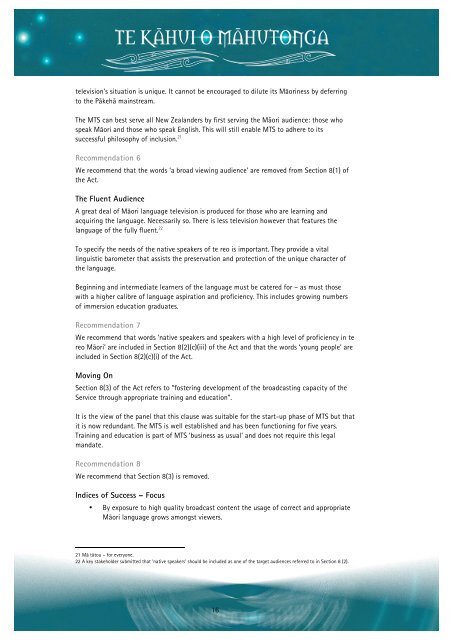Review of the Maori Television Service Act 2003: A ... - Te Puni Kokiri
Review of the Maori Television Service Act 2003: A ... - Te Puni Kokiri
Review of the Maori Television Service Act 2003: A ... - Te Puni Kokiri
- No tags were found...
Create successful ePaper yourself
Turn your PDF publications into a flip-book with our unique Google optimized e-Paper software.
television’s situation is unique. It cannot be encouraged to dilute its Mäoriness by deferringto <strong>the</strong> Päkehä mainstream.The MTS can best serve all New Zealanders by first serving <strong>the</strong> Mäori audience: those whospeak Mäori and those who speak English. This will still enable MTS to adhere to itssuccessful philosophy <strong>of</strong> inclusion. 21Recommendation 6We recommend that <strong>the</strong> words ‘a broad viewing audience’ are removed from Section 8(1) <strong>of</strong><strong>the</strong> <strong>Act</strong>.The Fluent AudienceA great deal <strong>of</strong> Mäori language television is produced for those who are learning andacquiring <strong>the</strong> language. Necessarily so. There is less television however that features <strong>the</strong>language <strong>of</strong> <strong>the</strong> fully fluent. 22To specify <strong>the</strong> needs <strong>of</strong> <strong>the</strong> native speakers <strong>of</strong> te reo is important. They provide a vitallinguistic barometer that assists <strong>the</strong> preservation and protection <strong>of</strong> <strong>the</strong> unique character <strong>of</strong><strong>the</strong> language.Beginning and intermediate learners <strong>of</strong> <strong>the</strong> language must be catered for – as must thosewith a higher calibre <strong>of</strong> language aspiration and pr<strong>of</strong>iciency. This includes growing numbers<strong>of</strong> immersion education graduates.Recommendation 7We recommend that words ‘native speakers and speakers with a high level <strong>of</strong> pr<strong>of</strong>iciency in tereo Mäori’ are included in Section 8(2)(c)(iii) <strong>of</strong> <strong>the</strong> <strong>Act</strong> and that <strong>the</strong> words ‘young people’ areincluded in Section 8(2)(c)(i) <strong>of</strong> <strong>the</strong> <strong>Act</strong>.Moving OnSection 8(3) <strong>of</strong> <strong>the</strong> <strong>Act</strong> refers to “fostering development <strong>of</strong> <strong>the</strong> broadcasting capacity <strong>of</strong> <strong>the</strong><strong>Service</strong> through appropriate training and education”.It is <strong>the</strong> view <strong>of</strong> <strong>the</strong> panel that this clause was suitable for <strong>the</strong> start-up phase <strong>of</strong> MTS but thatit is now redundant. The MTS is well established and has been functioning for five years.Training and education is part <strong>of</strong> MTS ‘business as usual’ and does not require this legalmandate.Recommendation 8We recommend that Section 8(3) is removed.Indices <strong>of</strong> Success – Focus• By exposure to high quality broadcast content <strong>the</strong> usage <strong>of</strong> correct and appropriateMäori language grows amongst viewers.21 Mä tätou – for everyone.22 A key stakeholder submitted that ‘native speakers’ should be included as one <strong>of</strong> <strong>the</strong> target audiences referred to in Section 8 (2).1616

















